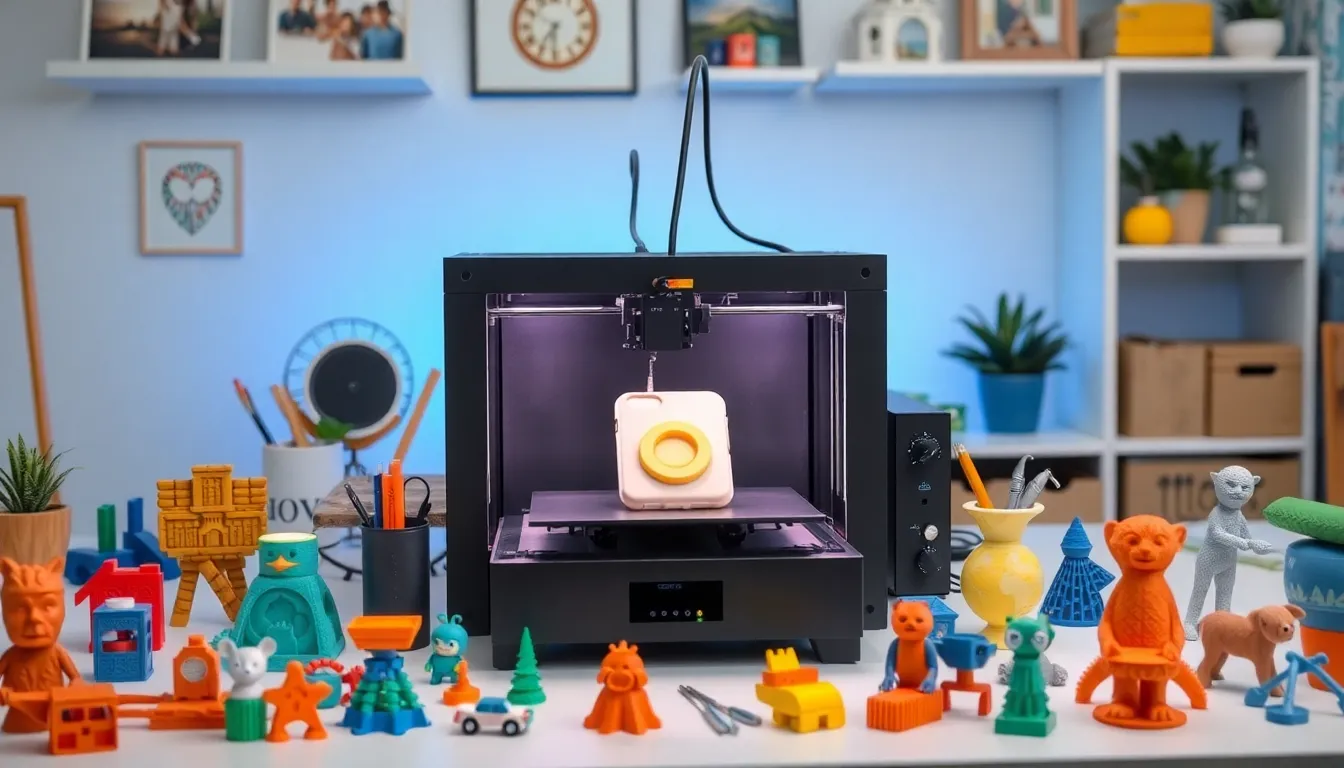In a world where printers spit out everything from photos to paperwork, why not let yours churn out cash? 3D printing isn’t just for tech enthusiasts anymore; it’s a goldmine for anyone ready to unleash their creativity and entrepreneurial spirit. Imagine transforming your wildest ideas into tangible products that people actually want to buy—sounds like a dream, right?
Table of Contents
ToggleUnderstanding 3D Printing
3D printing represents a groundbreaking technology transforming various industries. This process allows individuals to create physical objects from digital designs.
What Is 3D Printing?
3D printing, also known as additive manufacturing, creates three-dimensional objects layer by layer. This technique utilizes materials such as plastic, metal, or resin to produce items ranging from prototypes to final products. Various sectors, including healthcare, aerospace, and automotive, increasingly adopt 3D printing due to its versatility and efficiency. Customization becomes simple since designs can adjust quickly for unique needs.
How 3D Printing Works
3D printing involves several steps, starting with a digital 3D model. Designers often use software like CAD, creating detailed specifications for the desired object. The printer then reads the model and lays down material layer by layer according to the specifications. This additive process builds the object by adding material, resulting in complex shapes often impossible with traditional manufacturing methods. Post-processing may follow, ensuring a smooth finish or specific characteristics that enhance the final product.
Identifying Profitable Niches


Finding the right niche in 3D printing can lead to substantial earnings. Consider focusing on areas with high demand and limited competition.
Popular 3D Printed Products
3D printing has diversified its product offerings. Customized items such as phone cases and jewelry appeal to consumers looking for unique accessories. Prototyping tools cater to businesses needing rapid solutions for product development, while educational models like anatomical structures serve schools and institutions. Home décor items, including art sculptures and personalized gifts, also captivate a broad audience. Many seek out functional items, like spare parts or tools, that can be produced on demand. Exploring these categories can uncover profitable opportunities.
Market Demand Analysis
Analyzing current market trends is essential for identifying profitable niches. Industries such as healthcare increasingly explore 3D printing for custom prosthetics and surgical models. According to industry reports, the global 3D printing market is projected to grow by 20.8% annually through 2025, highlighting its expanding acceptance. Consumers favor personalized products, especially in fashion and home goods. Additionally, businesses are investing in rapid prototyping to cut costs and time in product development. Recognizing these trends helps in targeting lucrative avenues for 3D printing ventures.
Setting Up Your 3D Printing Business
Creating a successful 3D printing business involves thoughtful preparation and informed decisions. Key aspects include selecting the right equipment and understanding legal considerations.
Choosing the Right Equipment
Choosing equipment greatly impacts production quality and efficiency. Start with a reliable 3D printer that meets specific project needs. FDM printers suit beginners, while SLA printers deliver high-resolution results. Assess factors like build volume, material compatibility, and speed. Prioritize printers capable of utilizing multiple filament types for versatility. Purchase supporting tools, including slicer software and cleaning supplies, to enhance operation. Investing in a well-rounded setup fosters a smoother workflow and better end products.
Legal Considerations
Legal considerations cannot be overlooked when starting a 3D printing business. Understand copyright laws regarding digital designs. Create original or licensed files to avoid infringement issues. Research regulations pertaining to the sale of specific products, especially in sensitive industries like healthcare. Compliance with safety standards ensures the legality of items sold. Familiarizing oneself with local zoning laws is also crucial to avoid potential disruptions. Addressing these legal aspects upfront protects the business from future liabilities.
Marketing Your 3D Printing Services
Marketing 3D printing services requires a strategic approach to reach potential customers effectively. Utilizing various channels can enhance visibility and attract clients.
Building an Online Presence
Creating a professional website showcases 3D printing services. The website should highlight portfolios, customer testimonials, and service offerings. Social media platforms like Instagram, Facebook, and LinkedIn provide opportunities to engage with audiences. Consistent posting of high-quality images of finished products attracts attention. Additionally, using SEO techniques helps improve a website’s ranking in search engine results. Blogs focused on industry trends and tips position the business as a knowledgeable resource. Incorporating a clear call to action encourages visitors to inquire about services.
Networking and Collaborations
Connecting with local businesses can open new avenues for 3D printing projects. Attending industry events and joining professional organizations helps build a network of potential clients and partners. Collaborating with designers, engineers, or entrepreneurs broadens the service offerings and allows access to new markets. Establishing relationships with local makerspaces introduces the business to individuals interested in custom solutions. Referrals often come from satisfied clients and colleagues, leading to increased visibility and credibility in the industry. Building alliances strengthens the business and encourages word-of-mouth marketing.
Managing Finances and Growth
Managing finances effectively is crucial in a 3D printing business. Entrepreneurs must focus on pricing strategies and scaling operations to maximize profitability.
Pricing Your Products
Set competitive prices based on production costs and market demand. Research similar products to determine optimal price points. Include expenses such as materials and labor in calculations. Evaluate the value offered to customers; unique designs or customizations often justify higher prices. Consider offering discounts for bulk orders to attract larger clients. Adjust prices periodically according to market trends and customer feedback.
Scaling Your Business
Expand the business by diversifying product offerings and improving production efficiency. Focus on increasing production capacity through additional printers or advanced technology. Streamline operations by adopting automation where possible. Build partnerships with local businesses to access new markets and enhance visibility. Invest in marketing initiatives to reach a broader audience. Prioritize customer feedback to refine products and satisfy emerging demands.





